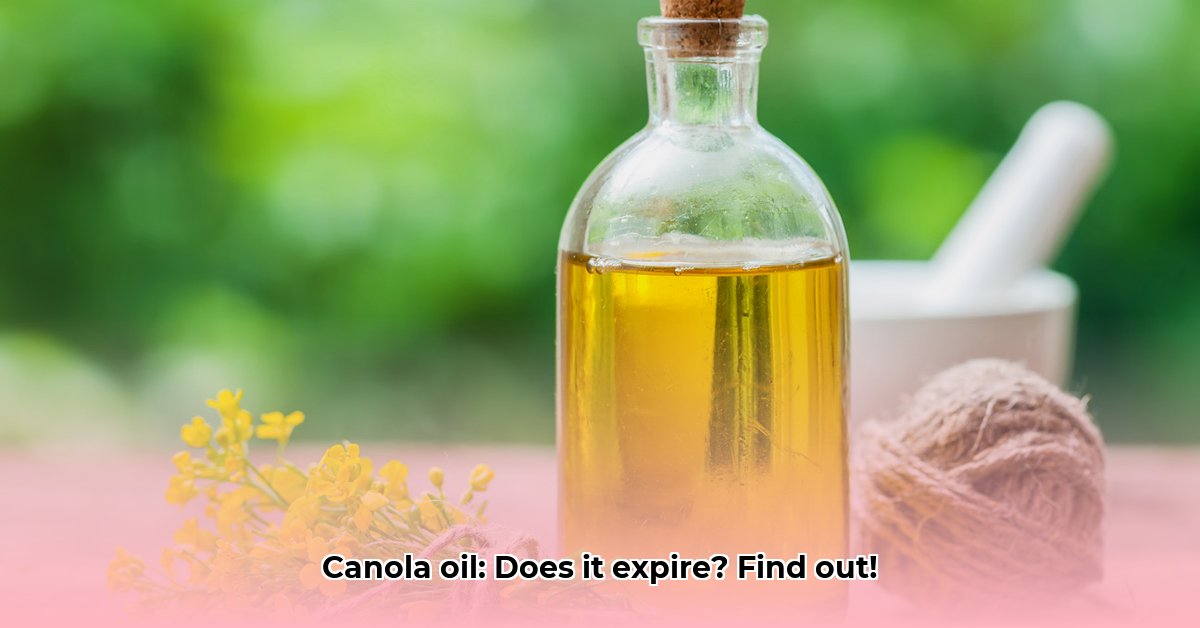Ever wonder how long that bottle of canola oil in your pantry is actually good for? Or maybe you’re trying to be more eco-friendly in the kitchen and want to know the best way to use it up before it goes bad. This guide is all about that – we’ll cover everything from how long canola oil lasts (both unopened and after you’ve started using it), to the best ways to store it so it stays fresh longer, and even how to dispose of it properly without harming the environment. We’ll look at what makes oil go rancid, give you simple tips to keep it fresh, and show you how to be more sustainable with your cooking. Let’s make sure you’re getting the most out of your canola oil, and doing it in a way that’s good for the planet too! Similar concerns apply to other pantry staples, like learning about water shelf life.
Does Canola Oil Go Bad? Shelf Life, Storage Tips & Safe Disposal
Let’s talk about canola oil—that ever-present staple in many kitchens. Does it go bad? The short answer is yes, just like any other oil, but understanding how and why it spoils helps you make it last longer and reduce waste. This isn’t just about saving money; it’s about being a more mindful consumer. Let’s explore how to safely use and handle your canola oil!
Understanding Canola Oil’s Shelf Life: More Than Just Dates
Unopened, a bottle of canola oil will typically stay good for one to two years. However, once you crack that seal and start pouring, the clock starts ticking much faster – think six to twelve months. Think of it this way: exposure to light, heat, and air is like a slow chemical reaction, silently leading to rancidity. This process breaks down the oil’s beneficial fatty acids, resulting in unpleasant flavors and potentially creating compounds that aren’t so good for you. How can you maximize its usable life and avoid waste?
A “best by” date on a bottle of canola oil is simply the manufacturer’s estimate of when the oil will be of best quality. It doesn’t necessarily mean the oil is unsafe to use after that date, but its flavor and nutritional value may have diminished. Factors like storage conditions significantly impact how long canola oil remains usable beyond the “best by” date. So, while you should pay attention to the date, rely more on your senses to determine if the oil is still good.
The Rancidity Check: Sniff, Look, and Taste (Carefully!)
So, how do you know if your canola oil has gone south? It’s easier than you think. Here are some key signs to watch out for:
- The Smell Test: Does it have a funky, musty, or unpleasant odor? Anything reminiscent of paint thinner, old crayons, or even a metallic scent is a major warning sign. Your nose is your best friend here!
- The Color Check: Has the oil noticeably darkened, become cloudy, or developed a sediment at the bottom? A significant change in color or clarity suggests that its quality is deteriorating.
- The Taste Test (Proceed with Caution!): A tiny taste test is the ultimate test. Does it taste bitter, soapy, sour, or strangely acrid? If the answer is yes, it’s time to say goodbye to that bottle. Remember, only take a tiny amount on the tip of your finger.
Before pouring any canola oil into your pan, always take a moment to give it the sniff and look-over test. If anything seems off—even the slightest hint of something “not quite right”—it’s best to err on the side of caution and discard it.
Storing Canola Oil: Maximize its Freshness
Proper storage is the key to extending the life of your canola oil. Here’s a simple, step-by-step guide to keep your canola oil fresher for longer:
Step 1: Container Choice Matters: Opt for a dark-colored, airtight container made of glass or high-quality, food-grade plastic. This minimizes light exposure, a major culprit in breaking down the oil. Avoid clear glass bottles; they let light in, accelerating that rancidity process. If your oil comes in a clear bottle, consider transferring it to a darker container.
Step 2: Location, Location, Location: Store your oil in a cool, dark, and dry place. Keep it away from direct sunlight, ovens, stoves, and other sources of heat and extreme temperature fluctuations—think your pantry, a cool kitchen cabinet, or even a basement storage area, not above the stove.
Step 3: Seal It Tight: After each use, make sure the container is tightly sealed. This prevents oxygen from getting in and causing oxidation. Consider using a bottle with a tight-fitting cap or even a stopper to ensure a secure seal.
Step 4: To Refrigerate or Not to Refrigerate?: While not absolutely necessary, refrigeration can slightly extend shelf life, particularly in warmer climates or if you don’t use the oil frequently. However, be aware that it might thicken the oil and make it slightly cloudy. This is normal and the oil will return to its normal consistency when brought back to room temperature.
Sustainable Practices: Think Beyond the Bottle
The question, “Does canola oil go bad?” isn’t just about the oil itself; it’s about how we deal with it once it’s past its prime. Pouring rancid oil down the drain is a big no-no – it can clog pipes, harm septic systems, and pollute our water. Instead, let’s get sustainable:
- Responsible Recycling: Check with your local waste management or recycling center about used cooking oil disposal programs. Some municipalities offer collection programs or designated drop-off locations for used cooking oil.
- Repurposing Possibilities: Some communities collect used cooking oil to make biodiesel fuel, animal feed, or even compost. See if your area has similar programs or partner with local farms or composting facilities.
- Solidifying for Safe Disposal: If you can’t recycle or repurpose the oil, solidify it before disposal. You can do this by mixing it with an absorbent material like kitty litter, sawdust, or coffee grounds. Once solidified, you can safely dispose of it in the trash.
- Conscious Consumption: Buy only the amount of canola oil you’ll realistically use before it goes bad. Plan your meals and consider purchasing smaller bottles to avoid waste. Store opened bottles in the refrigerator to further extend their life.
- Exploring Alternatives: Don’t be afraid to experiment! There’s a whole world of other healthy cooking oils out there, like olive oil, avocado oil, or coconut oil. Each offers unique flavors and benefits, and some may have longer shelf lives or better storage properties.
Comparing Storage Methods: A Quick Guide
Here’s a handy summary of the pros and cons of different storage methods:
| Storage Method | Pros | Cons |
|---|---|---|
| Cool, dark pantry | Convenient, reasonably good oil quality maintenance | Slightly faster oxidation compared to refrigeration |
| Refrigerator | Longest shelf life, best for longer storage | Oil may become thicker and cloud up |
| Improper Storage (e.g., direct sunlight) | None – Avoid this! | Extremely rapid oxidation, rancidity, and significant waste |
The issue of whether canola oil goes bad is more than just its shelf life. It’s about making smart, sustainable choices – using resources wisely and minimizing negative environmental impact. Hopefully this guide helps you handle your canola oil responsibly! How does mindful consumption benefit both your wallet and the planet?
How to Extend Canola Oil Shelf Life Sustainably
Key Takeaways:
- Unopened canola oil typically lasts one to two years. Opened oil should be used within six to twelve months for optimal quality.
- Light, heat, and air exposure dramatically shorten shelf life. Proper storage is key.
- Rancidity, signaled by off-odors and tastes, indicates spoilage. While generally not harmful, rancid oil loses nutritional value and tastes unpleasant.
- Sustainable practices include proper storage, mindful consumption, and responsible disposal.
Understanding Canola Oil’s Shelf Life: Key Factors affecting longevity
Have you ever wondered how long that bottle of canola oil in your pantry will stay fresh? It’s a question many home cooks ask. The answer depends on several factors. Unopened, canola oil, stored correctly, can last for one to two years. But once opened, that timeframe shrinks considerably – six to twelve months is a good target. After that point, the risk of rancidity increases. Did you know proper storage can extend the usable life of canola oil by up to 50%?
The refining process also plays a role in canola oil’s shelf life. Refined canola oil, which is most commonly found in stores, has a longer shelf life than unrefined canola oil. This is because the refining process removes impurities that can contribute to rancidity.
The Enemies of Fresh Canola Oil: Light, Heat, and Air
Think of canola oil as a sensitive plant. Light, heat, and air are its worst enemies. Exposure to light triggers oxidation, leading to rancidity. High temperatures accelerate this process. Air exposure, similarly, lets oxygen interact with the oil, again causing rancidity. These factors are why proper storage is essential to **how to extend canola oil shelf life
- Gluten Free Meal Prep Ideas for Delicious, Hassle-Free Eating - November 28, 2025
- Gluten Free Meal Prep for Stress-Free and Healthy Eating - November 27, 2025
- Quick And Easy Chicken Thigh Meal Prep For Weight Loss - November 26, 2025










